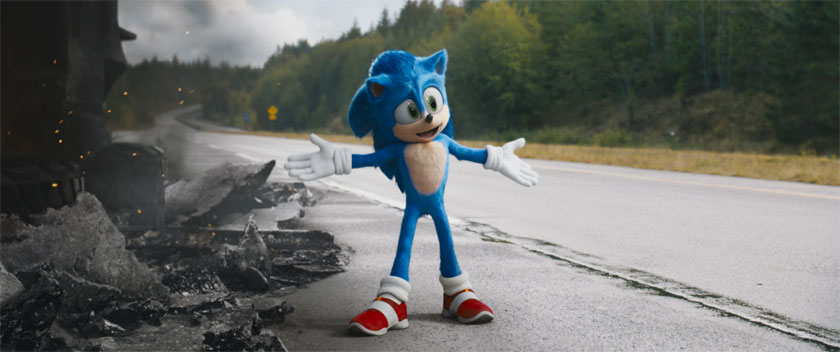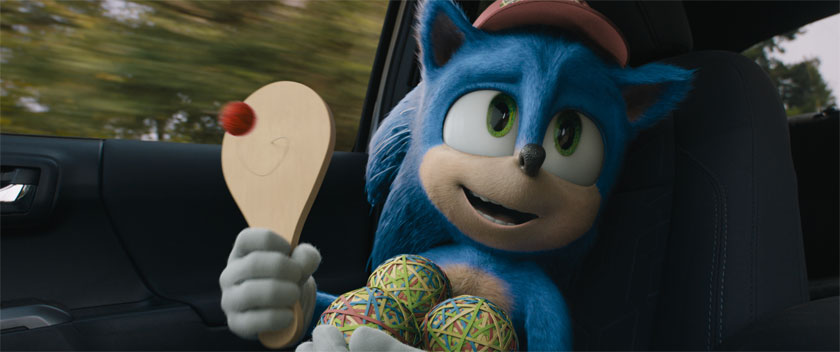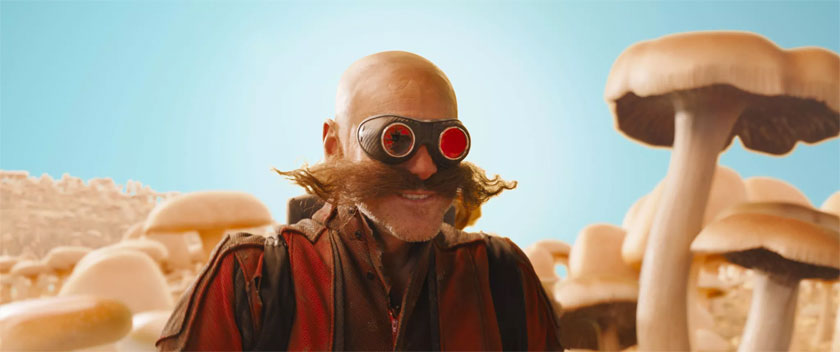The Curious Case of the Sonic the Hedgehog Film

I am not a Sonic the Hedgehog fan. That’s not a surprise when you consider my preferred childhood games were either story-focused Japanese role-playing games or side-scrolling action games that encouraged thorough exploration of the map. While the most obvious example of this preference is Super Metroid, a title such as Mega Man X would become my favorite entry in the Blue Bomber’s multi-generational saga due to its scattering of upgrades and power-ups across its levels. Super Mario World was littered with hidden secrets and additional exits to its stages, each one revealing alternate paths throughout the world map.
Sonic the Hedgehog did not reward exploration. It’s not that the game punished exploration, either. Sonic himself was just not built to thoroughly spelunk through his maps. Instead, it’s a try-try-again approach to progressing through each stage, maintaining that sense of flow in order to reach the end point. Mirror’s Edge is, in some ways, a spiritual successor to the more abstracted concept of platforming that Sonic the Hedgehog introduced.
Nonetheless, I was a child during the early days of the “console wars”, incited to anger by the SEGA marketing campaign that dared treat my beloved Super Nintendo as the “dweeby” console. My hatred of the smug smirk on the blue blur has not fully washed away, and has often felt justified as I’ve sat in the spectator’s seats of SEGA’s constant efforts to keep the character relevant through the shifting landscape of gaming. Perhaps most shocking is that, despite all of the “How do you do fellow kids?” the hedgehog has suffered and endured throughout the aughts, he has somehow managed to maintain a cross-generational fandom of near-religious – if not fully religious – devotion.
Oddly enough, it is this cross-generational fandom that makes last year’s Sonic the Hedgehog so widely accepted. It feels somewhat engineered to feed into the interests of nearly every target demographic within the anthropomorphic runner’s crowd of enthusiasts, but not in the same cynical fashion that you’d expect such a work to function. It doesn’t feel designed by committee, nor does it feel like a work shoved out onto the Internet by a mind that cannot comprehend humor, capable only of regurgitating that which is perceived as funny or amusing.
I think, most importantly, it recognizes that Sonic himself is not a character so much as an icon.
That may sound like a strange or contradictory statement. After all, one of the things that characterizes Sonic is that he’s cool, right? That’s certainly how SEGA advertised and portrayed him. Kind of strange that you’d rely on an anthropomorphized cartoon animal to appeal to the “older kids’’ in the audience, but somehow that smarmy smirk and impatient foot-tapping idle animation convinced a whole slew of children that, yes, this modern day Bugs Bunny was cooler than an Italian plumber in overalls.
I’d be lying if I said I’ve played a decent amount of Sonic games since the Genesis, but my time with Sonic Forces certainly continues that notion of a heroic rodent with attitude. What’s more, all the other characters seem to revere or respect Sonic, reminding the player constantly of just how cool and amazing and wonderful he is. Sonic is great and spectacular, and you should feel like he’s great and spectacular, too.

Yeah man, that’s just the epitome of cool right there.
Only that’s not at all who he is in the film. To a child he likely seems cool, but Sonic is effectively the irritating sidekick in his own film. He’s overly energetic and has an appetite for media, but his isolation has, effectively, made him a weirdo. Sonic is not admired, but endured for long enough that the plot can steer him into being adored instead.
This is not the Sonic that has existed in games, cartoons, and comics for the past thirty years. Even so, the film has been a major success in theaters for SEGA. This is in part due to the impact of Covid last year causing a series of films to be delayed, thus extending its stay on the big screen. While I think the film certainly got a boost from this extended box office exposure, I don’t think it is responsible for its success. I do not believe people saw it because “they may as well” or “there’s nothing else out”, but because the word of mouth was genuinely good.
In regards to that cross-generational appeal, however, I definitely feel as if this film was written and put together in a manner that would appeal to fans new and old alike. When the first trailer dropped online, I remarked on social media that it felt like it was pulled straight out of the 90’s. While my comment was primarily aimed towards the story pulling a cartoon character into our real world divorced from his imaginative, colorful video game origins and the grossly unnecessary and horrifying reinterpretation of the classic design, it superficially felt this way by using a tone deaf application of Coolio’s Gangsta’s Paradise with a very elastic and hyperactive Jim Carrey performance. Everything about it felt as if it was ripped from a prior era.
While that assessment was not wholly accurate, I do feel that Jim Carrey’s presence as Robotnik is in part to appeal to the nostalgia of the adults in the audience. Sonic is a character whose primary relevance as a cultural icon was in the 90’s, and while he’s not gone extinct, he most certainly hasn’t maintained that same relevance and popularity as he had when SEGA was building consoles to compete with Nintendo. Jim Carrey’s relevance was similarly at its height in the 90’s, back in the days when the fans of Sonic the Hedgehog would have been quoting lines from Ace Ventura: Pet Detective and The Mask on the playground or during lunch. While the actor has taken on performances both serious and comedic since then, his greater relevance to pop culture plummeted during the aughts and hasn’t quite recovered. His energetic and elastic behavior within this film offers a bit of nostalgia for the adults that remember his most popular performances while simultaneously delivering that same sort of animated appeal to a younger audience.
In short, Millennials that grew up enjoying Jim Carrey can now enjoy him in the same way with their children… though, this time, in a more age appropriate movie.

The trailer, of course, indicates another manner in which this film is designed to appeal to the fandom: meme-speak. Not full-fledged meme-speak, but boiling Robotnik’s lengthy insult to the military leader to “he thinks you’re basic” uses terminology skirting the surface of “Internet humor”; the precise sort of space the teenage-to-young-adult Sonic fandom would certainly be dwelling.
That this sense of humor crosses over greatly with relatable humor for children – Sonic performing “the floss” dance or imitating the typical opening lines of a live-streamer – is just icing on the cake. Perhaps I sound condescending by phrasing it that way – or perhaps I just sound old – but given how many children are connected to the Internet and finding entertainment through memes and YouTube rather than Saturday morning cartoons, it only makes sense that there’d be a shared point of reference. It’s not unlike how a show like Spongebob Squarepants lasted long enough to share points of humor and reference for more than a decade of children growing up.
Yet it feels disingenuous to call it a Sonic movie. It’s more like Who Framed Roger Rabbit? remade with a video game icon rather than cartoon one, and replacing the hand-drawn animation with computer generated graphics. Our protagonist’s plans and life are uprooted by an obnoxious anthropomorphic mammal that, by the end, he grows to love. It’s a pretty common plot – particularly for children’s films – and it shares almost nothing with the greater Sonic universe. To that end, I’d consider Detective Pikachu to have more in common with Who Framed Roger Rabbit? in terms of its world, as it was unashamed of its origins as a video game franchise. It was a live-action Pokémon film. Sonic the Hedgehog as it exists could have been created with any animal mascot. Yes, Detective Pikachu has a familiar buddy cop trope backing its protagonists, but the partnership with one’s Pokémon is a core concept that runs through the whole of the franchise. In what fashion is Sonic, who he is and what he stands for, reflected in the film that wouldn’t work just as well if he’d been replaced by, say, Mickey Mouse?
Nonetheless, I will at least give the film credit for staying true to certain elements of the games in subtle ways. Sonic finding interest in a Veterinarian and saving a turtle at the film’s start is no doubt rooted in his saving of woodland creatures from their forced servitude to Robotnik in the games. Golden rings act as warp zones within the games and similarly as cross-dimensional gateways in the Archie branded line of comics. Chili dogs and meme-worthy lines like “Gotta go fast” aren’t turned into a centerpiece or major one-liner, but minor comments or asides. This is contrary to the sort of wink-and-nudge tactics of throwing imagery from the games into the audience’s face, such as the awkward reinterpretation of nearly everything in the Super Mario Bros. film or even the series of Resident Evil movies.
I suppose, to boil it down, I didn’t cringe nearly as often as I was expecting to during Sonic the Hedgehog. Honestly, I was pretty entertained. My initial response was to wonder if I liked it better than Detective Pikachu. In the end, though, I can’t help but respect Detective Pikachu more due to the fact that it was unabashedly a movie about Pokémon in the world of Pokémon. Sonic the Hedgehog, on the other hand, may have the name, but… is it really Sonic?


